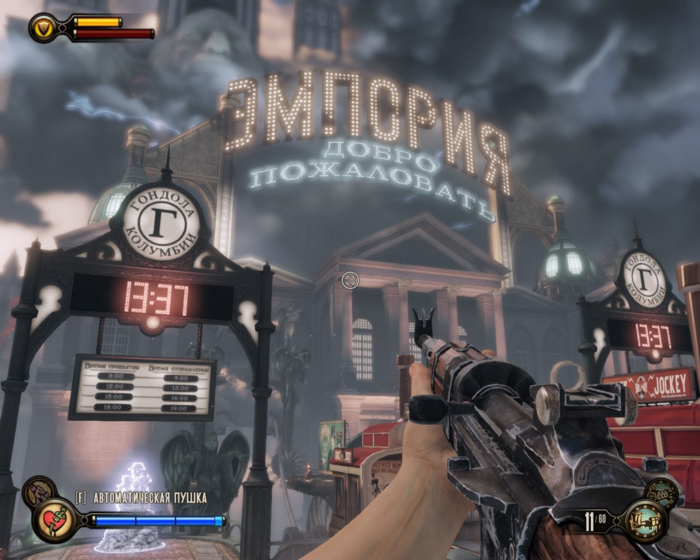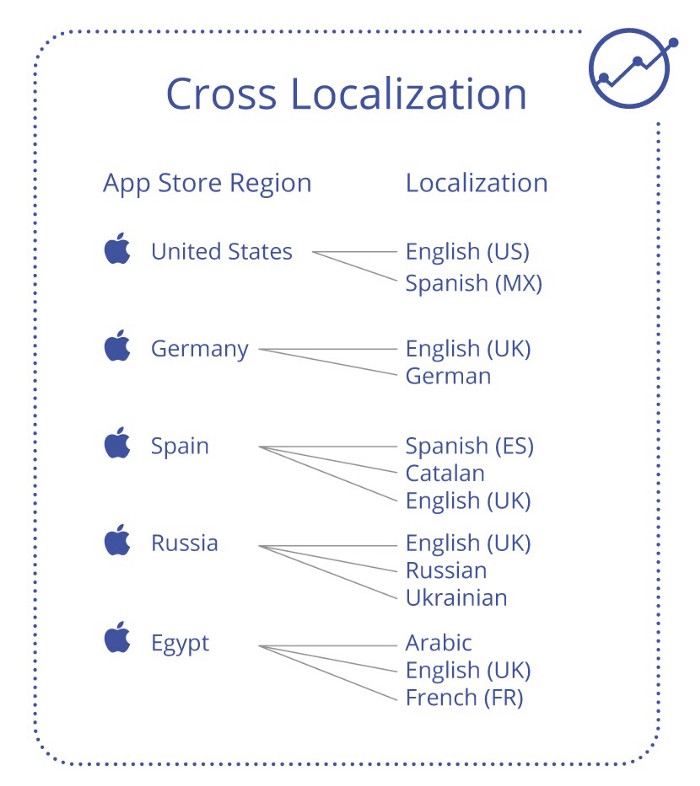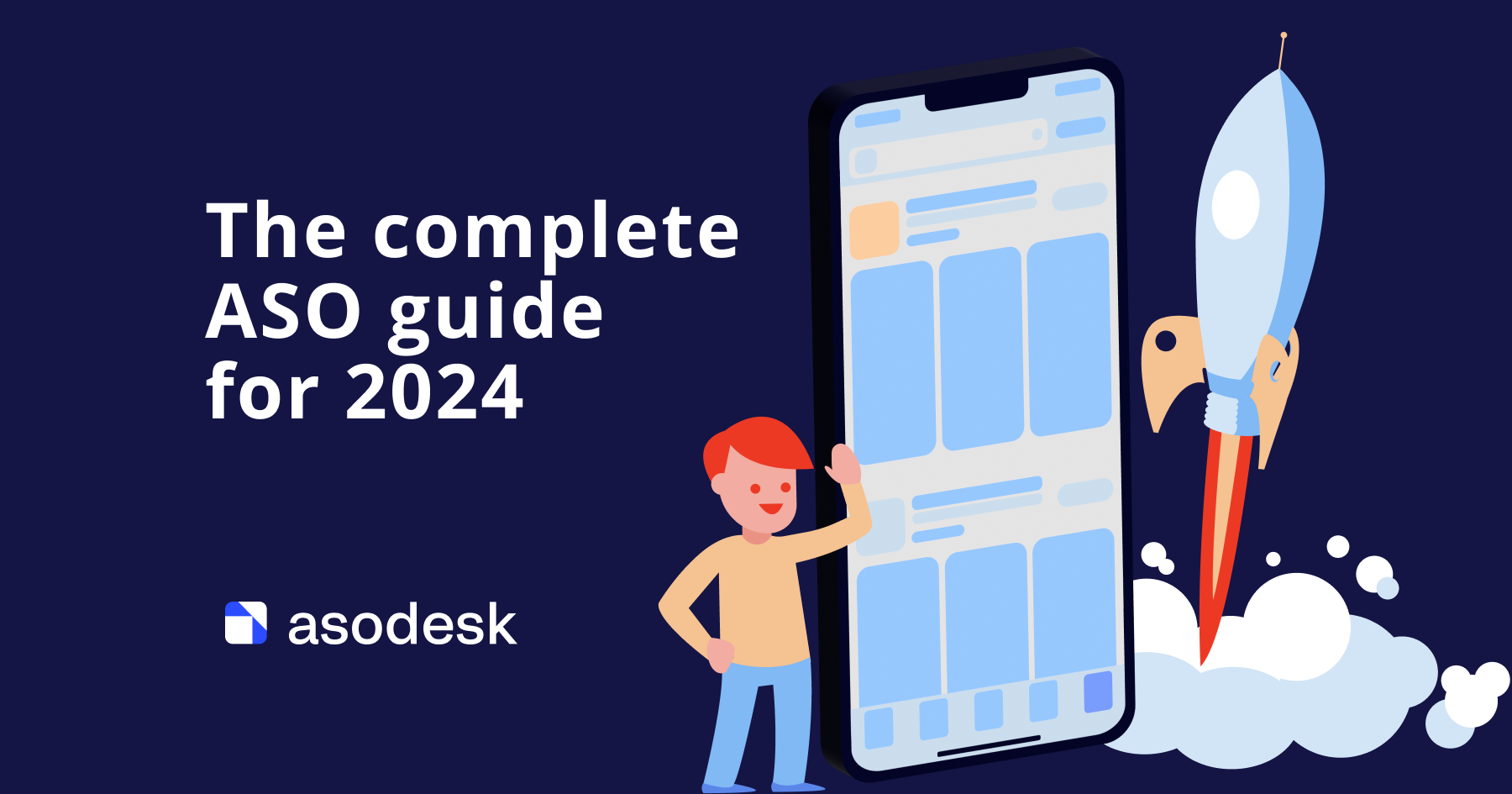ASO and App Localization: The Essential Strategy to Grow User Base

In this post, ASOdesk and Inlingo have teamed up to tell you about game and app localization. Based on our experience, we think that it is essential to localize both the interface and creative assets of a game and its app page on the App Store and Google Play.
Why is localization a necessary part of App Store Optimization?
The localization of metadata is an inherent part of app store optimization, especially if the developer wants to grow its user base in new markets. When localization is masterfully done, it increases the success of ASO and how users in a local market will receive the app.
If you localize your app in different languages, you can reach more people, rank higher for many popular search queries, and get ahead of competitors in local markets.
When you localize your app page on the App Store and Google Play, you need to not only translate popular keywords from one language to another, but also adapt them to cultural and linguistic nuances and find keywords and slang words that help drive more users to your app page.
For successful localization, it is essential to determine the relevant semantic core of the search queries that the potential audience uses when searching for apps and games in this category.
Just keep some advice in mind before you start collecting keywords for every additional language you plan to localize into:
- You need to create a semantic core of keywords in the native language of the product’s creators. This will give you a clear understanding of users’ behavior. Having a full semantic core for your app makes it easy to research new keywords in other languages.
- We recommend creating a list of English keywords. It is always easy to have metadata in English when you are planning to translate or localize into other languages.
- Create a list of competitors who already have top spots in the search results in countries where you plan to expand.
- Don’t use a literal translation, for example, from English to Spanish, or English to Chinese. Try to adapt search phrases to local search queries.
- Use the help of native speakers to collect keywords. They can give you explanations of local “slanguage”.
- Check keywords ranking in your niche. This will help you collect the most popular search phrases in the local market.
- Remember how search algorithms work. For example, the App Store algorithm can distinguish single and plural forms in English, but not in other languages.
- Remember that some languages have diacritics, and always check the correct spelling of keywords in every language. Sometimes you don’t need to use diacritics in keywords in the title and subtitle because users do not always use them when searching. Always check the traffic volume for keywords with and without diacritics.
- In some countries, you don’t even need to localize all keywords. In some countries, people search in English instead of their own language. Keywords in English could have more traffic than keywords in the local language.
- Also, don’t forget to track the metadata of your competitors. You can find the search phrases and keywords they use and add them to your metadata.
In ASOdesk, you can use the Keyword Explorer tool to research keywords in every language.
For example, let’s say you want to find new keywords for a running app, but in German. Let’s look at the search suggestions for the keyword “running” in the US App Store.

When you do the same research for the keyword “running” in German, you should also analyze all the search suggestions and check their relevancy.

By analyzing every keyword, you can find many additional search queries in each language and country. In every local market, pay attention to your competitors who are highly ranked in search results.
So, you have prepared your semantic core of keywords, planned changes to your app page in the App Store and Google Play, and localized the textual metadata in several languages, and now you are ready to conquer the world.
You need to ask yourself about your product. Is it ready for new markets? Have you localized the interface and the content inside the app?
Imagine that the ASO for your mobile game is perfect, but you didn’t localize it properly. Users have a great first impression, see your attractive icon and stunning screenshots, and like your description. But then, after downloading, they start playing the game. Some unexpected mistakes pop up. For example, some text that’s critical to understanding the game’s plot is not translated, the size of titles doesn’t match the size of buttons, or dialogs consist of strange phrases or jokes that are difficult to understand. Gamers want to have a perfect game experience, and if they are not satisfied with the content’s quality, they may quickly stop playing.
Or you can picture another situation where you have released a cooking app with recipes and want to succeed in the international market. You have created the app page and localized it into Spanish, but the interface and all the text is in English. Users who saw the description and attractive screenshots of the app could download it, but then they couldn’t use it in the right way because they don’t speak English. As a result, you will lose part of the audience and have lower retention.
That is why, before investing time and money in ASO in different languages, you should think about your users and who they are. If your app attracts tons of new users with its beautiful localized screenshots and title, but they can’t figure out how to use it, you could get a lot of bad reviews and lose users you attracted from search results. To avoid these negative consequences, we recommend planning for ASO and localization of the product page alongside the localization of the product itself.
Localizing mobile games and applications properly
Building an app localization process
Quality localization starts when an app is still under development. It’s essential to prepare a lockit that includes all the nuances and references that will help translators recreate a complete representation of the original game in another language.
The localization process itself is rather formulaic: a Project Manager gets a hold of the text, which is then given to the translation team, where it will spend most of its time. After the native speaker is done translating, editors take care of the text, correcting it according to genre specifications. Finally, if localization testing was ordered, editors check for linguistic quality assurance (LQA).
For proper localization, it’s best to provide translators with a data package, also known as a localization kit (lockit), which should include:
- Context and illustrations. It’s crucial to provide translators with context. For instance, the word “squash” on its own doesn’t specify whether the sport or plant is meant.
- Character limits. Try to make them as big as you can, since they are never enough.
- String IDs. It helps to know where this text will appear.
Also, keep in mind some more points:
- Formats that localizers commonly receive translation materials in, such as xls, txt, xml, html, csv, java, or json. these are the formats that translation software usually works with.
- Segmentation. There’s no need to break your sentence into several segments. For example, in Korean, sentences always end with a verb. If you break a sentence in Russian into several pieces, it’s going to be very difficult to translate.
- Filtering and sorting. Localizers are experienced people, so there’s no sense in even trying to help by filtering and sorting the text and deleting repetitions. Simply give it to them in a logical sequence.
- Dialogs with speakers and character biographies. For example, Korea has a very strict social hierarchy. If the characters in your game communicate with one another, their relationships are very important, as are their sex, age, social position, and family ties. Let’s say you have a very simple game in which two characters are talking. No one will be able to translate it into Korean without information about who these characters are to each other.
The technical task completed by the Project Manager is just as important. Among other things, all this data will be used to create a glossary of terms necessary to translate the project.
Things a localizer should pay attention to
Localizers need to pay attention to details that may seem insignificant, since these are what often cause the most trouble. Let’s take a look at some errors in particular game projects that were localized by other companies.
Take a look at the Resident Evil series. Even though it’s a long-running fan favorite, its localization far from perfect.

In the file, this line looks like this: “Очень туго <color = “66FF00”>завинчено</color>”. Obviously, the developer lost the space before the color tag. This could have been solved through additional localization testing, which is when bugs like this are often discovered.

There are tons of errors resulting from bad localization from Japanese to English in the game Ys VIII: Lacrimosa of DANA. They include text repetitions, poor translations, semantic errors, and bad lexical mistakes. The game’s creators have announced that it will be released on iOS and Android, and it would be nice if they conducted localization testing before it is launched. Unhappy gamers took to Reddit and Twitter, posting screenshots with obvious screw-ups. This is a prominent example of how even simple translation issues can turn gamers against a product (in this case, the publisher had to apologize for the poor localization).
Speaking of fans, quite often there are people who are very unhappy with the official localization, which means an end to positive PR. In fact, this was the exact reason behind a scandal that surrounded the game Fire Emblem Fates (you can read an article about this on Kotaku).
Fans were unhappy with the fact that their favorite game was not localized in the US, but rather censored and given an extremely artistic translation.

Fans compared screenshots from the Japanese and English versions. They were particularly outraged by this moment. Seriously, what is that “Rrrghg” anyway?
Projects like this with a big fan base should always be approached very carefully. It’s important to remember your fans are your main audience. They will not forgive a frivolous treatment of their favorite game. Negative feedback, angry Reddit threads, and maybe even a Vice takedown about it will follow.
And here are some examples of good localization. On the screenshot below, you can clearly see the in-game elements in a non-commercial Russian localization of BioShock Infinite performed by the CGInfo team.


Top image: original English version of BioShock Infinite; bottom image: localized Russian version of the same game. Excellent work with fonts and design of in-game objects.
There are localizations in which the visual component of the project gets a complete makeover, leaving only the game’s mechanics.
This is exactly what INLINGO did with the Chinese title about the Three Kingdoms, ultimately turning a historical game into a post-apocalyptic one. In this way, the isometric RTS mechanic was preserved, but the characters, units, and objects were replaced in accordance with the new setting. The client considered this necessary because a game about the Three Kingdoms in China wouldn’t be relevant in Russia and the USA for anyone except a narrow audience with an interest in Asian history.


Top image: screenshot for the Chinese store; bottom image: screenshot for the Russian store. Note the drastic atmosphere change: not only in character skins, but fonts too.
In the Asodesk blog, we share experts’ tips on ASO and mobile app marketing and the latest news in the industry. Subscribe to our newsletter and never miss out on our articles!
The most localization-sensitive markets
Indeed, the importance of adaptation, which is not included in a regular translation, can’t be overestimated for a wide range of markets. Besides cultural features (such as wearing green hats in China, where they were historically worn by the husbands of prostitutes), there are things that are prohibited by law or decried by influential communities or organizations, which may lead to an app being banned from the market.
For instance, in China, game censorship is handled by a special organization, the Online Game Ethics Committee. During the first few months of its operation, the committee has held back about half of all games in review at the time “until the removal of moral harm” has occurred. The list of requirements is rather strict and looks like this:
- If a game is part of a franchise, it has to be outlined separately. Otherwise, the regulator will consider the project as having the same name as another one and will not provide a license.
- If an online game has offline components, developers have to explain how they work.
- Games shouldn’t contain images of dead bodies or an abundance of blood. At the same time, you can’t just change the color of blood.
But at the same time the process became easier: mobile publishers don’t have to send smartphones with their pre-installed games to SAPP (a department that currently controls this niche), and they don’t have to provide a printed version of prohibited words for each game. They can simply provide a digital list.
In Arab countries, you will most likely have to clothe your characters and keep them from drinking alcohol and gambling. In addition, you will have to avoid religious topics, especially those related to Islam.
In Germany, it’s important to follow rather strict requirements regarding violent scenes in games.
Proper localization is the key to users’ hearts.
In the App Store, you can use localization to not only promote your app in other markets, but also increase the number of characters for the country that is most important for your marketing strategy. This is helpful, for example, when you want to be ranked for new keywords in the US, but also don’t want to remove keywords from your current metadata. In this case, you can use cross-localization and the Spanish MX locale.
In some countries, you can double the number of keywords. Check out this table with current information about the countries.

If, for example, you want to reach new places in search results, but you already used up all your characters in the metadata, you can use English UK for additional keywords for the Spanish market.
These keywords will be indexed in Spain and other countries, but not the USA, Australia, Canada, and Japan. You can add keywords for Spain in the keyword field (100 characters), the title (30 characters), and the subtitle (30 characters).
Remember that you can combine keywords only in one locale. You can’t create search phrases from keywords in different locales. If you have the keyword “calorie” in the Spanish MX locale and “counter” in the English US locale, you will not be indexed for the search phrase “calorie counter” in the US.
Remember alphabets, grammar rules, spelling, and special symbols in other languages. These features must be considered when working with ASO, where every character is worth its weight in gold. Here is some advice about ASO localization from ASO experts:
German
Johannes von Cramon ASO, ASA, Analytics & Retention at Growfirst @https://twitter.com/jovcra
For German localization, all translations should be done by a native speaker. Sometimes we also saw an increase in CR by writing in a certain German dialect (e.g. in Bavarian for a feature launch only available in Munich). But that’s more of an edge case. An advantage in Germany might be that most of the graphical A/B tests for screenshots, videos, etc. are done in English speaking countries, which is why we can easily adapt those new and innovative concepts and benefit from the fact that almost nobody in Germany has seen those concepts before. An example for this might be the app preview from the app “Komoot”. I’ve seen the approach a couple of times in the US, but never here.
In terms of keywords, the German language is a little bit tricky, because Apple and Google algorithms are far better in connecting plural/singular forms, detecting misspellings, and recognizing relevance between keywords and apps.
Japan Language
Hiroto Inada (Repro Inc.), ASO expert
@ https://twitter.com/HirotoInada
In Japan, we use four types of characters in our daily life.
1. English:’game,’ ‘kids,’ etc.
2. Kanji: `無料` , `子供` etc.
3. Hiragana: `こども` , `げーむ`
4. Katakana: `キッズ` , `げーむ`
In the title, you need spaces between each keyword to be indexed. For example, the title キッズ無料ゲーム (“Kids free games”) has a high risk of rejection since it seems to be just adding keywords, not a sentence. I recommend using in the title some postpositional particles such as `や` , `が` and `の`, so that the title seems more natural in Japanese. As for the keyword field , you don’t need spaces between the different types of character shown above since each keyword is indexed as another language. For example , `キッズ無料こどもkids`
For what types of apps is localization essential?
You need to localize the interface and content of the app if it has a lot of text in it. We understand that “a lot of textual content” is a very subjective evaluation it could be 5,000 characters or 10,000. Still, what is most important is the text’s role in helping users understand the app’s features.
If your application or game was created in English, you can enter the English speaking market. Still, English is not the mother tongue of people from many other countries, and they will not understand some of the product’s nuances or content. And they will probably not see the value of using it.
Localization is necessary if the company releases a unique app that has no analogs on the market. Users of such apps don’t have any relevant experience with them, and you need to explain how to use the app, what functions it has, and its value. But if your app’s UX consists of pictograms, you don’t need to explain every step or onboard using text. In this case, it is not necessary to localize.
When you plan to release your product in new markets, we think that it is crucial to localize the app/game together with the app page and ASO for the local market. You should think about localization during the development stage. Then you should plan the app store optimization, including all textual and visual elements of the product page in app stores. If you do both these things, you will have more advantages than your competitors, and users will be satisfied using the product in their native language.
Here is proof of how localization can positively impact organic downloads based on cases from mobile projects that used localization and ASO optimization for local markets:
Elena Naumova, CMO DEVGAME
1. Application Robocar Poli
We updated the the game version last spring and localized: translated the game into new languages, including voiceovers in these languages and the interface. We updated all textual metadata: the title, subtitle, and description. We localized screenshots for the App Store and Google Play page.
Results:
iOS: Downloads have grown in the French market. After we added the Arabic localization, we saw a growth in organic downloads in Arabic-speaking regions.
Android: After localization, Indonesia came in first forthe most downloads, followed by Russia in second place and Brazil in third.
2. Kid-E-Cats: Kitchen Games, iOS
We localized the app into more than 10 languages. We saw growth in organic installs in Spanish-speaking countries. When we added ASO in Vietnamese, we started to get organic installs from there, and now Vietnam is the country with the third-most downloads compared to other regions.
Vladimir Suhodolov, independent ASO expert
In one of our applications, we changed the subscription pop-up. The subscription screen comes up first in the app, but we did it without proofreading by a native speaker. Then we found a native speaker and changed the screen based on her advice — removed errors in the text, added informal phrases — and after the release, we saw the results. The purchase conversion rate from this pop-up increased.
Localization of an app in our portfolio. We did ASO and localization for Scandinavian countries. We saw search keywords with a good traffic volume. The next month, we localized the app and saw traffic grow in Europe. For example, a growth of 13% in Sweden, 38% in Denmark and 26% in Norway.
For the help in creating the article, many thanks to INlINGO; Johannes von Cramon ASO, ASA, Analytics & Retention at Growfirst Hiroto Inada (Repro Inc.) ASO expert; Elena Naumova, CMO DEVGAME; Vladimir Suhodolov, independent ASO expert.











